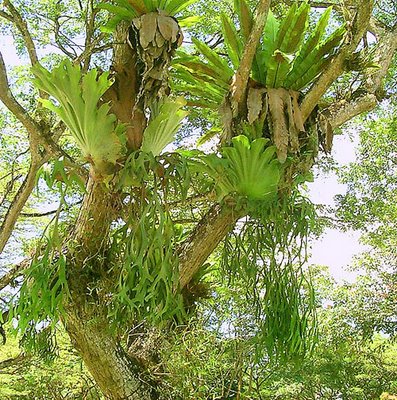
These are tender, tropical Ferns that must be grown in a
greenhouse. They are found wild in tropical Africa, Asia, Malaya,
Madagascar, Java, and Australia. They look quite different from the
average Fern. They have two kinds of fronds, barren and fertile. The
fertile (spore-bearing) fronds are from 18 inches to 3 feet long, flat,
narrow at the base and then spread out widely at the tips, where they
are divided deeply giving a look resembling antlers of a stag or elk,
thus the name Staghorn Fern. These fronds are pendulous and produce
spores in large, uneven patches. The base from which these fronds hang
are the barren fronds. They are thin, almost round leaves that are
green when young, but as they age, turn brown and papery. These fronds
lie flat against the surface from which they grow (which would be
trunks and branches of trees as these Ferns are epiphytal), collecting
food material and supporting the plant. Dead leaves and organic
material collect behind them and provide the Fern with nourishment.
Their thin, threadlike roots also cling to the branches of the trees
and absorb their moisture from the water that trickles down the trunks.
Small green buds that grow at irregular spots on the roots, eventually
expand and develop new plants.
Potting
Most of these Ferns require a minimum winter temperature of 55
degrees, but one kind, P. bifurcatum (alcicorne), which is a native to
Australia, can be grown in a greenhouse with a minimum winter
temperature of 45 degrees. They need a light, porous soil that can hold
moisture in well. The best compost consists of equal parts of orchid
peat (osmunda fiber) and finely chopped sphagnum moss. A small amount
of crushed charcoal, which prevents the compost from becoming sour, and
some half-decayed oak leaves should be added. There are several
different ways to cultivate these Ferns. In a greenhouse large slabs of
cork bark can be attached to the wall to form pockets, the compost is
then inserted behind the cork and the plants, placed on the surface of
the compost, are held in place by wooden pegs. They can also be grown
on pieces of tree trunk, which are held up in a vertical position,
either by inserting them in the soil in the floor of the greenhouse or
in large flowerpots. The plants are held in position by a little
compost being placed behind the barren or clasping fronds. First they
are fixed to the trunk with an encircling band of thin wire, but later
on they'll attach and support themselves. When growing these plants in
pots, a slab of cork bark, or a piece or tree branch, preferably Cedar,
Redwood, Cypress, or some other long-lasting kind, which has a length
that is twice the depth of the pot, is placed upright in the pot. The
pot should almost be filled up with crocks to provide excellent
drainage and hold the bark or branch in place. The plant is then
attached to the bark or branch in the way described. The barren fronds
will eventually conceal the support completely from view. The soil must
be kept moist throughout the entire year. During the summer, water is
applied in profusion, but in the winter months, just as the soil is
approaching dryness. After they have been attached to their support,
these Ferns shouldn’t be disturbed. A top-dressing of fresh compost
should be given every spring to keep them growing actively. They need
shade from strong sunlight and a humid atmosphere, which can be
maintained by wetting the benches and floor of the greenhouse whenever

Species of staghorn fern, Platycerium, typically produce
one or more broad, clasping leaves, called niche or shield leaves, next
to the trunk at the base of the plant, in addition to lobed, projecting
leaves. The niche leaf produces a sheltered, wet microhabitat for the
adventitious roots, within which organic matter, hence vital nutrients
can accumulate. Commonly, the niche leaf turns light brown with age.
Propagation
All kinds, except P. grande, produce small rooted Ferns from
their bases. These may be detached and planted in a pan of sifted soil
compost. They are held in place by pegging them down with pieces of
wire bent to hairpin shape or with wooden pegs. The soil is kept moist
and when they're large enough, they're fixed to their permanent spots
as previously described. These Ferns may also be raised from spores,
but this method is rarely used (except for P. grande, the kind that
doesn't produce small plants), because it is a much slower process. The
spores must be fully ripe. To test them for ripeness, a frond is
gathered when the spores are brown and placed in a paper bag. This is
hung in a position with good ventilation for a few days. The spores
that are found at the bottom of the bag are ripe enough to plant. A
deep pan or pot is almost filled up with crocks over which a layer of
rough peat or moss is placed. The rest of the space is filled with peat
moss and finely chopped sphagnum moss. The spores are sprinkled on top
of the soil and are kept moist by setting the pot in a saucer of water.
Growth is very slow, but when they're large enough to handle, they are
lifted carefully and placed 2 inches apart in deep pans filled with
similar compost, where they are kept moist until they're large enough
to fix to their permanent positions.
needed.
Varieties
For the cool greenhouse - P. bifurcatum (alcicorne).
For the hothouse - P. grande; P. Willinckii; P. Stemaria (aethiopicum).


No comments:
Post a Comment